Chart Color Schemes
est. as @ -- *
ABS ERP | -- people | --
2021 Census | -- people
Sales Activity
Curious about local property values? Filter the chart to assess the volume and appreciation (including resales) trends and regional comparisons, or scroll to the map below view this information at an individual property level.
Find a Recent Sale
Sales Detail
Population
An assessment of population growth drivers in Northern Peninsula reveals an overall ranking slightly below national averages considering recent, and medium term trends
Northern Peninsula's population is approximately 2,928 as of August 2025. This figure represents an increase of 147 people since the 2021 Census, which reported a population of 2,781. The change is inferred from the estimated resident population of 2,928 in June 2024 and one validated new address since the Census date. This results in a density ratio of 2.8 persons per square kilometer. Northern Peninsula's growth rate of 5.3% since the 2021 census exceeds that of the SA4 region (3.7%) and the SA3 area, indicating it as a growth leader in the region. Natural growth contributed approximately 96.8% of overall population gains during recent periods.
AreaSearch adopts ABS/Geoscience Australia projections for each SA2 area, released in 2024 with a base year of 2022. For areas not covered and years post-2032, Queensland State Government's SA2 area projections are adopted, released in 2023 based on 2021 data. However, these state projections do not provide age category splits, so AreaSearch applies proportional growth weightings in line with ABS Greater Capital Region projections for each age cohort, released in 2023 using 2022 data. Based on projected demographic shifts, a population increase just below the median of Australia's regional areas is expected by 2041, with an increase of 144 persons and a total gain of 4.9% over the 17 years.
Frequently Asked Questions - Population
Development
Residential development activity is lower than average in Northern Peninsula according to AreaSearch's national comparison of local real estate markets
Northern Peninsula has recorded approximately 13 residential properties granted approval annually. Over the past five financial years, from FY-21 to FY-25, 67 homes were approved, with none yet recorded in FY-26. On average, around 0.4 new residents arrive per new home each year over this period, indicating that supply is meeting or exceeding demand and providing greater buyer choice while supporting potential population growth above projections.
The average expected construction cost value of new dwellings is $971,000, suggesting developers are targeting the premium market segment with higher-end properties. This financial year has seen $2.6 million in commercial development approvals recorded, reflecting the area's residential character. Compared to the rest of Queensland, Northern Peninsula shows moderately higher construction activity, at 49.0% above the regional average per person over the five-year period, balancing buyer choice with support for current property values.
All new construction during this period has been comprised of detached houses, preserving the area's low-density nature and attracting space-seeking buyers. Notably, developers are building more traditional houses than the current mix suggests (80.0% at Census), indicating continued strong demand for family homes despite density pressures. The location has approximately 124 people per dwelling approval, indicating a low-density market. Future projections show Northern Peninsula adding 144 residents by 2041. At current development rates, new housing supply should comfortably meet demand, providing good conditions for buyers and potentially supporting growth beyond current population projections.
Frequently Asked Questions - Development
Infrastructure
Northern Peninsula has emerging levels of nearby infrastructure activity, ranking in the 20thth percentile nationally
Area infrastructure performance is significantly influenced by local changes. AreaSearch has identified 0 projects impacting this area. Key projects are Queensland National Land Transport Network Maintenance, Queensland Energy and Jobs Plan SuperGrid, Queensland Energy and Jobs Plan, repeated thrice. Relevant projects are listed below.
Professional plan users can use the search below to filter and access additional projects.
INFRASTRUCTURE SEARCH
 Denotes AI-based impression for illustrative purposes only, not to be taken as definitive under any circumstances. Please follow links and conduct other investigations from the project's source for actual imagery. Developers and project owners wishing us to use original imagery please Contact Us and we will do so.
Denotes AI-based impression for illustrative purposes only, not to be taken as definitive under any circumstances. Please follow links and conduct other investigations from the project's source for actual imagery. Developers and project owners wishing us to use original imagery please Contact Us and we will do so.
Frequently Asked Questions - Infrastructure
Queensland Energy and Jobs Plan
State-wide renewable energy transformation program delivering large-scale wind, solar, pumped hydro, battery storage and transmission infrastructure. Aims for 70% renewable energy by 2032 and 80% by 2035, supporting 100,000 jobs by 2040 across regional Queensland. Largest clean energy investment program in Australia.
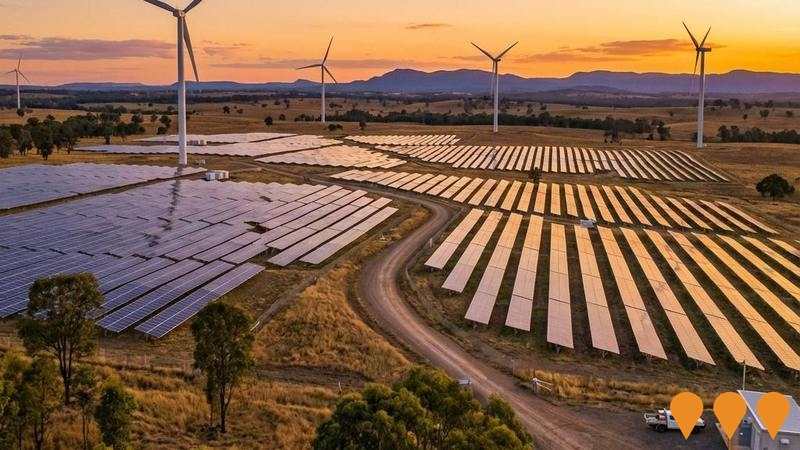
Queensland Energy and Jobs Plan SuperGrid
The Queensland Energy and Jobs Plan is delivering the Queensland SuperGrid and 22 GW of new renewable energy capacity through Renewable Energy Zones (REZs) across the state. Legislated targets are 50% renewables by 2030, 70% by 2032 and 80% by 2035. Key delivery mechanisms include the Energy (Renewable Transformation and Jobs) Act 2024, the SuperGrid Infrastructure Blueprint, the Queensland REZ Roadmap and the Priority Transmission Investments (PTI) framework. Multiple transmission projects are now in construction including CopperString 2032, Gladstone PTI (Central Queensland SuperGrid), Southern Queensland SuperGrid reinforcements, and numerous grid-scale batteries and pumped hydro projects under active development.
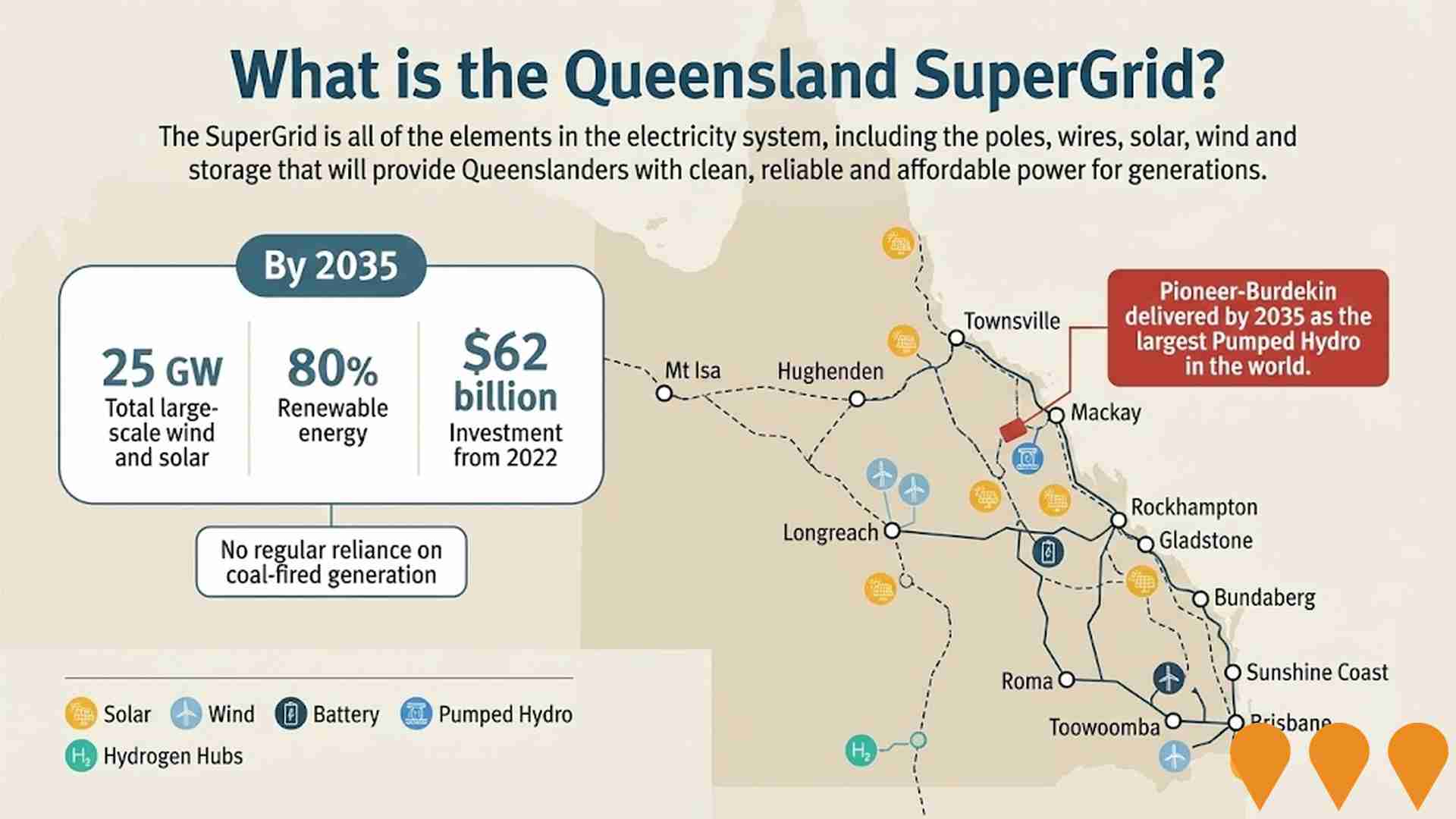
Queensland Energy and Jobs Plan
The Queensland Energy and Jobs Plan is a $62 billion+ statewide program to deliver publicly owned renewable energy generation, large-scale battery and pumped hydro storage, and the Queensland SuperGrid transmission backbone. Targets: 50% renewables by 2030, 70% by 2032, 80% by 2035. Multiple projects are now under construction including CopperString 2032, Pioneer-Burdekin Pumped Hydro, and numerous Renewable Energy Zones.
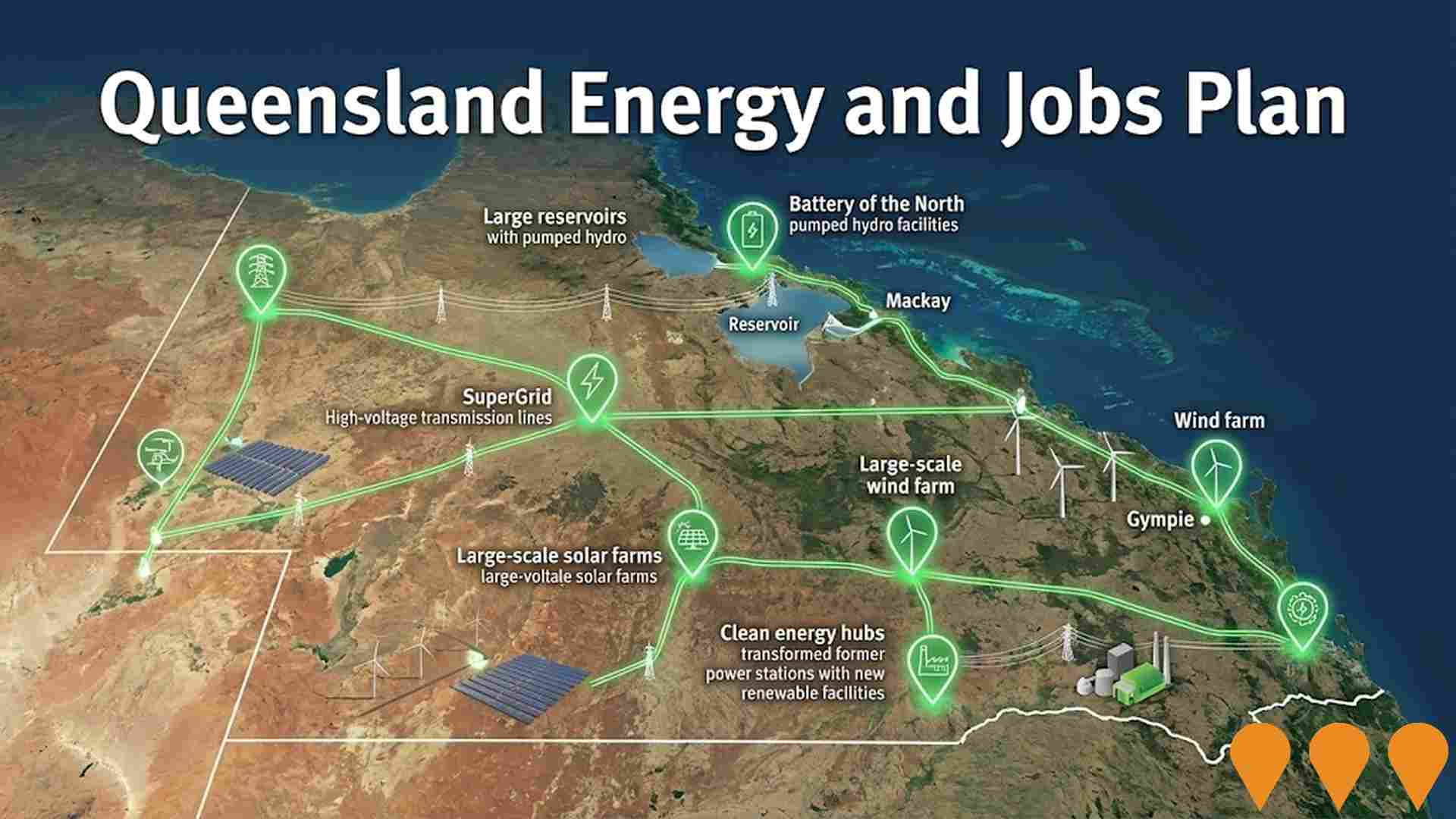
Queensland Energy Roadmap Infrastructure
The Queensland Energy Roadmap 2025 is the State Government's strategic plan to deliver affordable, reliable, and sustainable energy. Replaces the former Energy and Jobs Plan, focusing on extending the life of state-owned coal assets, a $1.6 billion Electricity Maintenance Guarantee, and the $400 million Queensland Energy Investment Fund. Key infrastructure includes the CopperString transmission line and new gas-fired generation, while the Pioneer-Burdekin Pumped Hydro project has been cancelled in favor of smaller storage options.
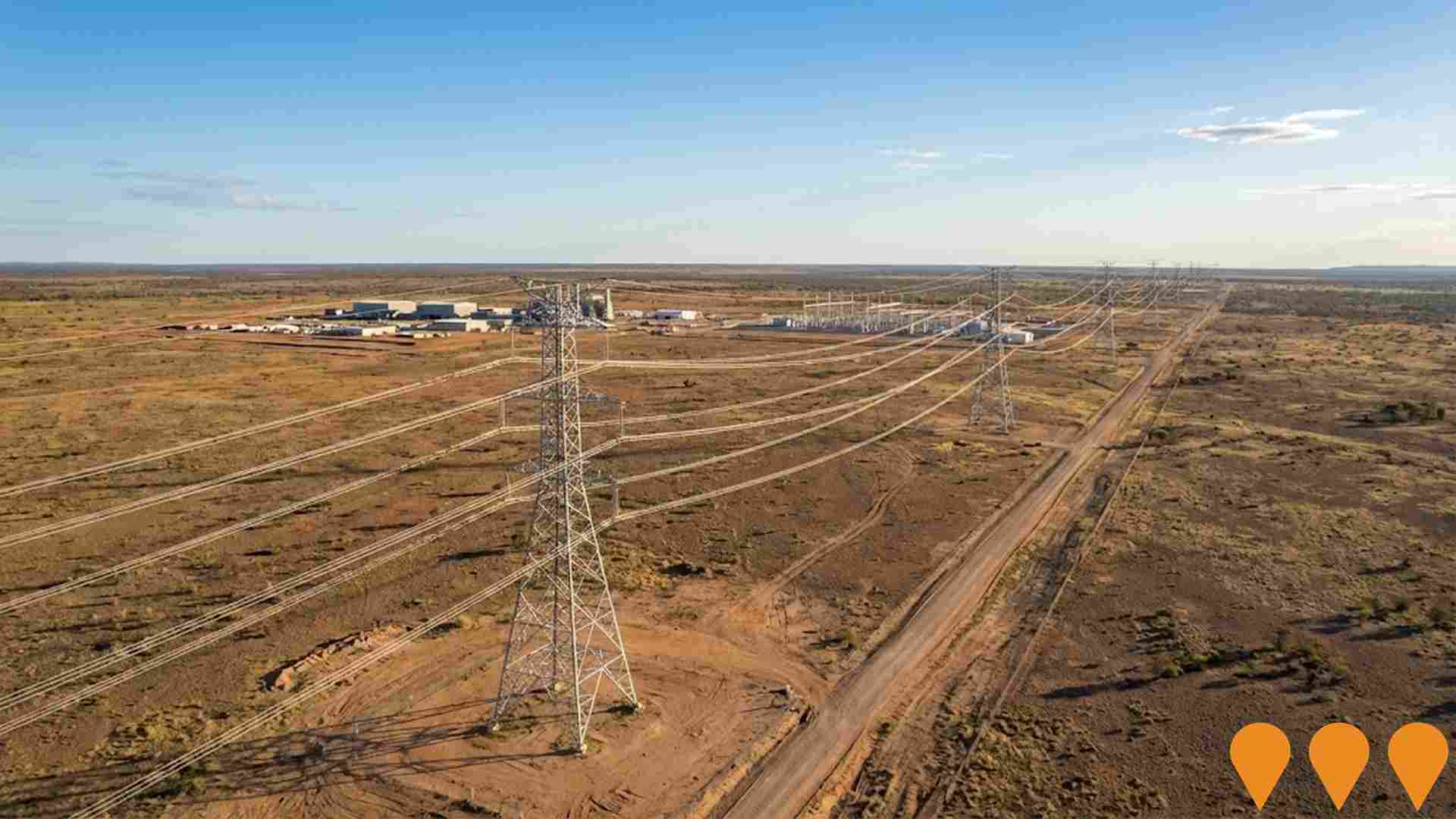
Building Future Hospitals Program
Queensland's flagship hospital infrastructure program delivering over 2,600 new and refurbished public hospital beds by 2031-32. Includes major expansions at Ipswich Hospital (Stage 2), Logan Hospital, Princess Alexandra Hospital, Townsville University Hospital, Gold Coast University Hospital and multiple new satellite hospitals and community health centres.

Enabling Digital Health Services for Regional and Remote Australia
National initiative to expand and improve digital health access for people in regional and remote Australia. Focus areas include enabling telehealth and virtual care, upgrading clinical systems and connectivity, supporting secure information exchange, and building workforce capability in digital health, aligned with the Australian Government's Digital Health Blueprint and Action Plan 2023-2033.
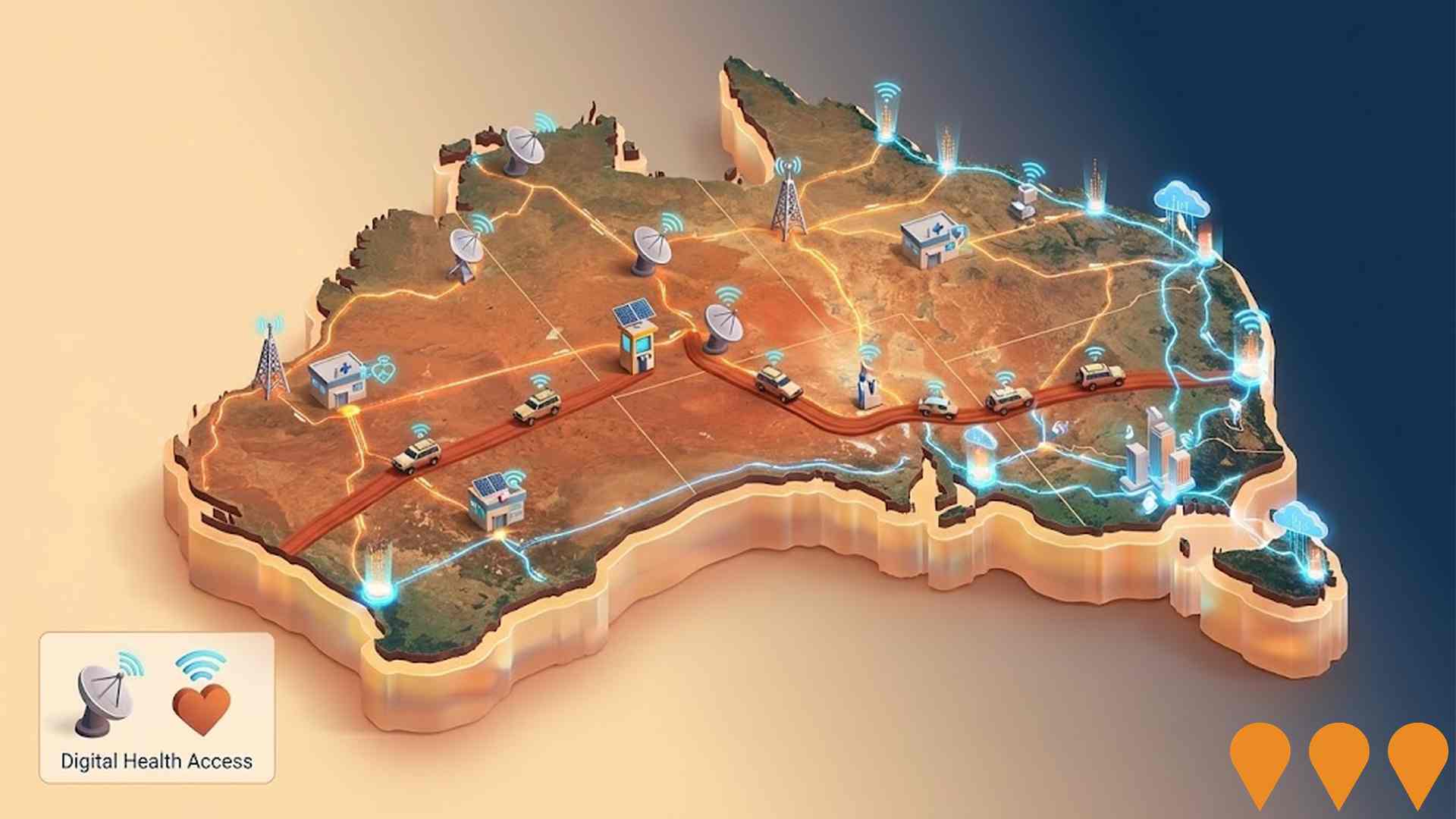
Enabling Infrastructure for Hydrogen Production
Australia has completed the National Hydrogen Infrastructure Assessment (NHIA) to 2050 and refreshed its National Hydrogen Strategy (2024). The programmatic focus has shifted to planning and enabling infrastructure through measures such as ARENA's Hydrogen Headstart and the Hydrogen Production Tax Incentive (from April 2025). Round 2 of Hydrogen Headstart consultation occurred in 2025. Collectively these actions aim to coordinate investment in transport, storage, water and electricity inputs linked to Renewable Energy Zones and priority hubs, supporting large-scale renewable hydrogen production and future export supply chains.
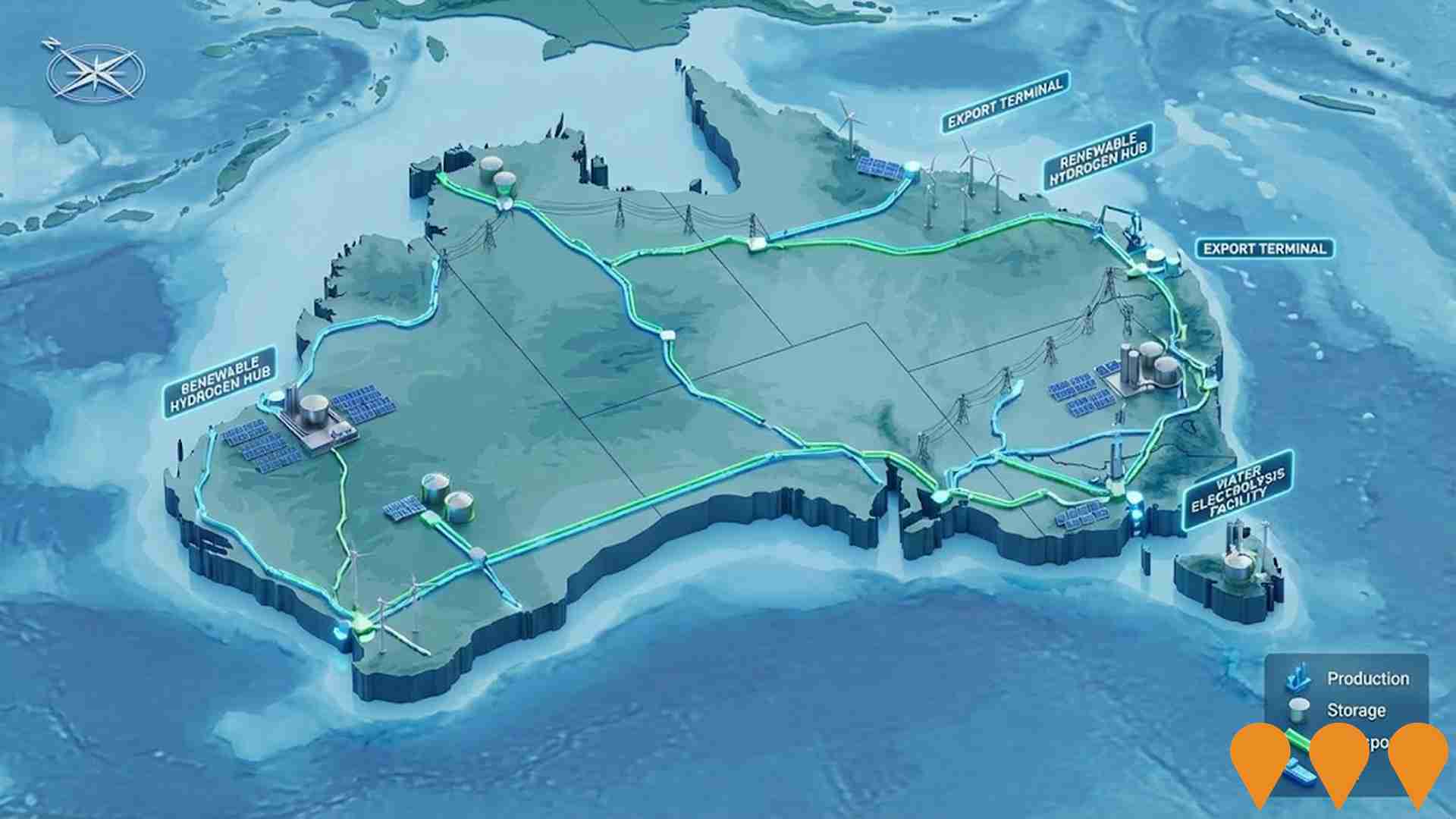
National EV Charging Network (Highway Fast Charging)
Partnership between the Australian Government and NRMA to deliver a backbone EV fast charging network on national highways. Program funds and co-funds 117 DC fast charging sites at roughly 150 km intervals to connect all capital cities and regional routes, reducing range anxiety and supporting EV uptake.

Employment
Employment conditions in Northern Peninsula face significant challenges, ranking among the bottom 10% of areas assessed nationally
Northern Peninsula has a diverse workforce with both white and blue collar jobs, with essential services well represented, and an unemployment rate of 12.1% as of June 2025. There are 1,052 residents employed while the unemployment rate is 8.2 percentage points higher than the Rest of Qld's rate of 3.9%.
Workforce participation in Northern Peninsula lags at 53.7%, compared to 59.1% in the Rest of Qld. The leading employment industries among residents are health care & social assistance, public administration & safety, and education & training. Public administration & safety is particularly specialized with an employment share three times the regional level, while manufacturing has a limited presence at 1.1%, compared to the regional average of 5.6%. Local employment opportunities appear limited, as indicated by the Census working population count versus resident population.
Over the 12 months to June 2025, labour force levels increased by 0.4% while employment declined by 2.6%, resulting in a rise in unemployment rate by 2.7 percentage points. In comparison, Rest of Qld recorded employment growth of 1.8% and labour force growth of 2.0%, with unemployment rising by 0.2 percentage points. Jobs and Skills Australia's national employment forecasts from May 2025 suggest potential future demand within Northern Peninsula. These projections estimate national employment growth of 6.6% over five years and 13.7% over ten years, but growth rates vary significantly between industry sectors. Applying these industry-specific projections to Northern Peninsula's employment mix suggests local growth of approximately 6.9% over five years and 14.5% over ten years.
Frequently Asked Questions - Employment
Income
Income figures position the area below 75% of locations analysed nationally by AreaSearch
Northern Peninsula had median taxpayer income of $44,442 and average income of $52,738 in financial year 2022. This was lower than national averages, with Rest of Qld having median income of $50,780 and average income of $64,844. By September 2025, estimated median income would be approximately $50,659 and average $60,116, based on Wage Price Index growth of 13.99% since financial year 2022. According to 2021 Census figures, incomes in Northern Peninsula fell between the 12th and 22nd percentiles nationally. Income analysis showed that 31.0% of residents (907 people) earned between $1,500 - 2,999, similar to regional levels at 31.7%. Housing costs were manageable with 91.1% retained, but disposable income was below average at the 32nd percentile.
Frequently Asked Questions - Income
Housing
Northern Peninsula is characterized by a predominantly suburban housing profile, with a higher proportion of rental properties than the broader region
Northern Peninsula's dwelling structures, as per the latest Census, were 79.9% houses and 20.1% other dwellings (semi-detached, apartments, 'other' dwellings), compared to Non-Metro Qld's 82.5% houses and 17.6% other dwellings. Home ownership in Northern Peninsula was at 2.1%, with mortgaged dwellings at 0.5% and rented ones at 97.4%. The median monthly mortgage repayment was $1,300, below Non-Metro Qld's average of $1,517. Median weekly rent in Northern Peninsula was $120, compared to Non-Metro Qld's $140. Nationally, Northern Peninsula's mortgage repayments were significantly lower than the Australian average of $1,863, and rents were substantially below the national figure of $375.
Frequently Asked Questions - Housing
Household Composition
Northern Peninsula features high concentrations of family households, with a higher-than-average median household size
Family households account for 78.5% of all households, including 35.5% couples with children, 12.8% couples without children, and 27.7% single parent families. Non-family households make up the remaining 21.5%, with lone person households at 20.6% and group households comprising 1.0%. The median household size is 3.5 people, which is larger than the Rest of Qld average of 2.9.
Frequently Asked Questions - Households
Local Schools & Education
Northern Peninsula faces educational challenges, with performance metrics placing it in the bottom quartile of areas assessed nationally
The area faces educational challenges, with university qualification rates at 10.4%, significantly lower than the Australian average of 30.4%. This presents both a challenge and an opportunity for targeted educational initiatives. Bachelor degrees are the most prevalent at 7.0%, followed by graduate diplomas at 1.9% and postgraduate qualifications at 1.5%. Trade and technical skills are prominent, with 53.6% of residents aged 15+ holding vocational credentials - advanced diplomas at 9.3% and certificates at 44.3%.
Educational participation is notably high, with 41.2% of residents currently enrolled in formal education. This includes 22.5% in primary education, 12.7% in secondary education, and 1.0% pursuing tertiary education. Northern Peninsula's 4 schools have a combined enrollment of 624 students as of the latest data (2021). The area demonstrates varied educational conditions across Northern Peninsula, with an educational mix comprising 2 primary schools, 1 secondary school, and 1 K-12 school. School capacity exceeds typical residential needs, with 21.3 places per 100 residents compared to the regional average of 15.4, indicating that the area serves as an educational center for the broader region. Note: where schools show 'n/a' for enrolments, please refer to the parent campus.
Frequently Asked Questions - Education
Schools Detail
Nearby Services & Amenities
Transport
No public transport data available for this catchment area.
Frequently Asked Questions - Transport
Transport Stops Detail
Health
Northern Peninsula's residents boast exceedingly positive health performance metrics with very low prevalence of common health conditions across all age groups
Health outcomes data shows excellent results across Northern Peninsula with very low prevalence of common health conditions across all age groups. The rate of private health cover is found to be very low at approximately 47% of the total population (~1,367 people), compared to 49.9% across Rest of Qld and the national average of 55.3%. Diabetes and asthma were the most common medical conditions in the area, impacting 6.3 and 3.7% of residents respectively, while 85.1% declared themselves completely clear of medical ailments compared to 79.2% across Rest of Qld.
The area has 5.7% of residents aged 65 and over (167 people), which is lower than the 11.5% in Rest of Qld. Health outcomes among seniors require more attention despite the broader population's strong results.
Frequently Asked Questions - Health
Cultural Diversity
The level of cultural diversity witnessed in Northern Peninsula was found to be above average when compared nationally for a number of language and cultural background related metrics
Northern Peninsula had 2.7% of its population born overseas and 82.8% speaking a language other than English at home, both figures above the regional averages. Christianity was the predominant religion in Northern Peninsula, with 75.9%, compared to 64.7% across Rest of Qld. In terms of ancestry, Other was the largest group at 53.0%, significantly higher than the regional average of 28.1%.
Australian Aboriginal followed at 35.8%, also higher than the regional average of 25.3%. English ancestry made up 3.6%, notably lower than the regional average of 14.2%. Maori ethnicity was notably overrepresented in Northern Peninsula, with 0.5% compared to 0.4% regionally.
Frequently Asked Questions - Diversity
Age
Northern Peninsula hosts a very young demographic, ranking in the bottom 10% of areas nationwide
Northern Peninsula's median age is 23 years, which is notably lower than both Queensland's average of 41 years and Australia's average of 38 years. Relative to the Rest of Queensland, Northern Peninsula has a higher concentration of residents aged 5-14 (22.1%), but fewer residents aged 65-74 (4.2%). This concentration of 5-14 year-olds is well above the national average of 12.2%. According to the 2021 Census, the population aged 65 to 74 has grown from 3.7% to 4.2%, while the 0 to 4 age group has declined from 11.4% to 10.0% and the 5 to 14 age group has dropped from 23.5% to 22.1%. Population forecasts for 2041 indicate significant demographic changes for Northern Peninsula, with the 25 to 34 age group expected to grow by 24%, reaching 554 people from 447. Conversely, the 55 to 64 and 15 to 24 age cohorts are projected to experience population declines.




